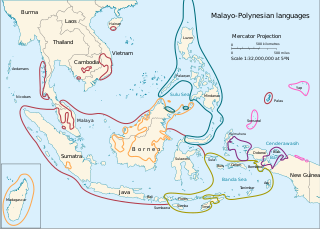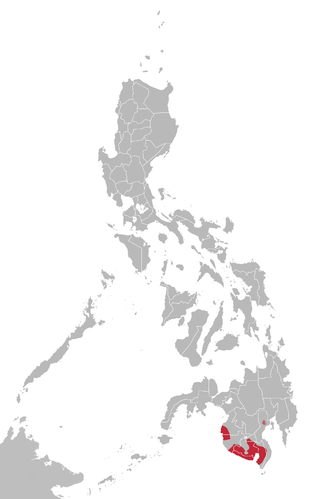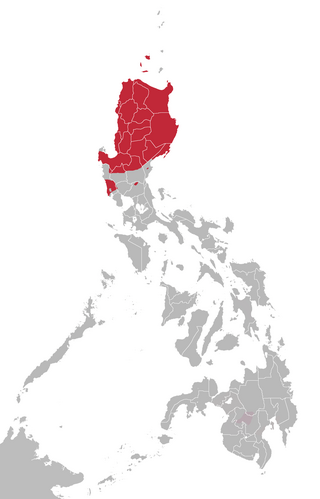Related Research Articles

The Malayo-Polynesian languages are a subgroup of the Austronesian languages, with approximately 385.5 million speakers. The Malayo-Polynesian languages are spoken by the Austronesian peoples outside of Taiwan, in the island nations of Southeast Asia and the Pacific Ocean, with a smaller number in continental Asia in the areas near the Malay Peninsula, with Cambodia, Vietnam and the Chinese island Hainan as the northwest geographic outlier. Malagasy, spoken in the island of Madagascar off the eastern coast of Africa in the Indian Ocean, is the furthest western outlier.

The Bisayan languages or Visayan languages are a subgroup of the Austronesian languages spoken in the Philippines. They are most closely related to Tagalog and the Bikol languages, all of which are part of the Central Philippine languages. Most Bisayan languages are spoken in the whole Visayas section of the country, but they are also spoken in the southern part of the Bicol Region, islands south of Luzon, such as those that make up Romblon, most of the areas of Mindanao and the province of Sulu located southwest of Mindanao. Some residents of Metro Manila also speak one of the Bisayan languages.
The Central Philippine languages are the most geographically widespread demonstrated group of languages in the Philippines, being spoken in southern Luzon, Visayas, Mindanao, and Sulu. They are also the most populous, including Tagalog, Bikol, and the major Visayan languages Cebuano, Hiligaynon, Waray, Kinaray-a, and Tausug, with some forty languages all together.

The Philippine languages or Philippinic are a proposed group by R. David Paul Zorc (1986) and Robert Blust that include all the languages of the Philippines and northern Sulawesi, Indonesia—except Sama–Bajaw and a few languages of Palawan—and form a subfamily of Austronesian languages. Although the Philippines is near the center of Austronesian expansion from Formosa, there is little linguistic diversity among the approximately 150 Philippine languages, suggesting that earlier diversity has been erased by the spread of the ancestor of the modern Philippine languages.

The Batanic languages are a dialect cluster of the Austronesian language family. They are spoken on Babuyan Island, just north of Luzon; three of the Batanes Islands, between the Philippines and Taiwan; and on Orchid Island of southern Taiwan.
The Meso-Cordilleran languages are a group of languages spoken in or near the Cordillera Central mountain range in Northern Luzon. Its speakers are culturally very diverse, and include the lowland Pangasinense, the Igorot highlanders, and Alta-speaking Aeta groups.
The Southern Mindoro languages are one of two small clusters of Austronesian languages spoken by the Mangyan people of Mindoro Island in the Philippines. They make up a branch of the Greater Central Philippine subgroup.
The Northern Mindoro languages are one of two small clusters of languages spoken by the Mangyan people of Mindoro Island in the Philippines.
The Subanen languages are a group of closely related Austronesian languages belonging to the Greater Central Philippine subgroup. Often described as a single language, they are considered by linguists as a dialect cluster more than a monolithic language. Subanen languages are spoken in various areas of Zamboanga Peninsula, namely the provinces of Zamboanga Sibugay, Zamboanga del Norte and Zamboanga del Sur, and in Misamis Occidental of Northern Mindanao. There is also a sizeable Subanen community in Misamis Oriental. Most speakers of Subanen languages go by the name of Subanen, Subanon or Subanun, while those who adhere to Islam refer to themselves as Kalibugan.

The South Mindanao or Bilic languages are a group of related languages spoken by the Bagobo, Blaan, Tboli, and Teduray peoples of the southern coast of Mindanao Island in the Philippines. They are not part of the Mindanao language family that covers much of the island. The languages are:
The Gorontalo–Mongondow languages are a group of Austronesian languages spoken in northern Sulawesi, Indonesia.
The Palawanic languages are a subgroup in the Greater Central Philippine-family spoken on the island of Palawan and nearby islets.
The Greater Central Philippine languages are a proposed subgroup of the Austronesian language family, defined by the change of Proto-Malayo-Polynesian *R to *g. They are spoken in the central and southern parts of the Philippines, and in northern Sulawesi, Indonesia. This subgroup was first proposed by Robert Blust (1991) based on lexical and phonological evidence, and is accepted by most specialists in the field.
The Negrito peoples of the Philippines speak various Philippine languages. They have more in common with neighboring languages than with each other, and are listed here merely as an aid to identification.
Umiray Dumaget Agta is an Aeta language spoken in southern Luzon Island, Philippines.
The Proto-Philippine language is a reconstructed ancestral proto-language of the Philippine languages, a proposed subgroup of the Austronesian languages which includes all languages within the Philippines as well as those within the northern portions of Sulawesi in Indonesia. Proto-Philippine is not directly attested to in any written work, but linguistic reconstruction by the comparative method has found regular similarities among languages that cannot be explained by coincidence or word-borrowing.
The Kalanguya are an Austronesian ethnic group most closely associated with the Philippines' Cordillera Administrative Region, but whose core population can be found across an area which also includes the provinces of Nueva Vizcaya, Nueva Ecija, and Pangasinan. While this area spans Region I, the Cordillera Administrative Region, and Region II, it represents a largely geographically contiguous area. The Kalanguya are considered a subgroup of the Ifugao people.

The Northern Luzon languages are one of the few established large groups within Philippine languages. These are mostly located in and around the Cordillera Central of northern Luzon in the Philippines. Among its major languages are Ilocano, Pangasinan and Ibanag.
The Central Cordilleran languages are a group of closely related languages within the Northern Luzon subgroup of the Austronesian language family. They are spoken in the interior highlands of Northern Luzon in the Cordillera Central mountain range.
R. David Zorc is an American linguist primarily known for his work on Austronesian languages and linguistics, particularly the Philippine languages.
References
- ↑ Reid, Lawrence A. (2006). "On reconstructing the morphosyntax of Proto-Northern Luzon, Philippines". Philippine Journal of Linguistics. 37: 1–64.
- 1 2 3 4 Himes, Ronald S. (1998). "The Southern Cordilleran Group of Philippine Languages". Oceanic Linguistics. 37 (1): 120–177. doi:10.2307/3623282. JSTOR 3623282.
- 1 2 Zorc, R. David (1979). "On the Development of Contrastive Word Accent: Pangasinan, a Case in Point". In Nguyễn Đ.L. (ed.). Southeast Asian linguistic studies, Vol. 3. Pacific Linguistics, C-45. pp. 241–258. doi:10.15144/PL-C45.241.